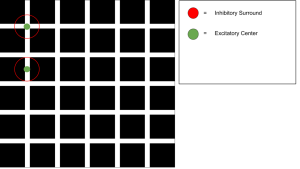Light and Eyeballs
76
Learning Objectives
Be able to describe what lateral inhibition is.
Be able to give at least one example of lateral inhibition or an illusion caused by it.
Lateral inhibition is a secondary signal sent by a neuron to reduce the responses of neighboring neurons when firing information. In vision, this can be observed through a neuron that is responding to differences in light, which will fire one signal of information about light to the next level in vision while a second signal is sent to neighboring neurons to suppress their firing rate. This suppression of response in neighboring neurons helps to pinpoint visual information by exaggerating differences in light.
There are four basic types of lateral inhibition:
- Transient response with an excitatory center and inhibitory surrounding, or a shorter response in the retinal ganglion cells (RGC) with a receptive field that has a high firing rate in the center and low firing rate in the surrounding part of the receptive field.
- Transient response with an inhibitory center and excitatory surrounding, or a shorter response in the RGC with a receptive field that has a low firing rate in the center and high firing rate in the surrounding part of the receptive field.
- Sustained response with an excitatory center and inhibitory surrounding, or a longer response in the RGC with a receptive field that has a high firing rate in the center and low firing rate in the surrounding part of the receptive field.
- Sustained response with an inhibitory center and excitatory surrounding, or a longer response in the RGC with a receptive field that has a low firing rate in the center and high firing rate in the surrounding part of the receptive field.
Lateral inhibition can explain Mach bands, or the illusion that light and dark lines exist adjacent to sudden changes in brightness, and the gray dots that appear between intersections in the Hermann grid illusion (Fig.8.11.1).

CC LICENSED CONTENT, SHARED PREVIOUSLY
Cheryl Olman PSY 3031 Detailed Outline
Provided by: University of Minnesota
Download for free at http://vision.psych.umn.edu/users/caolman/courses/PSY3031/
License of original source: CC Attribution 4.0
NOBA, Vision
Provided by: University of Illinois at Urbana-Champaign
URL: https://nobaproject.com/modules/vision
License: CC BY-NC-SA 4.0

